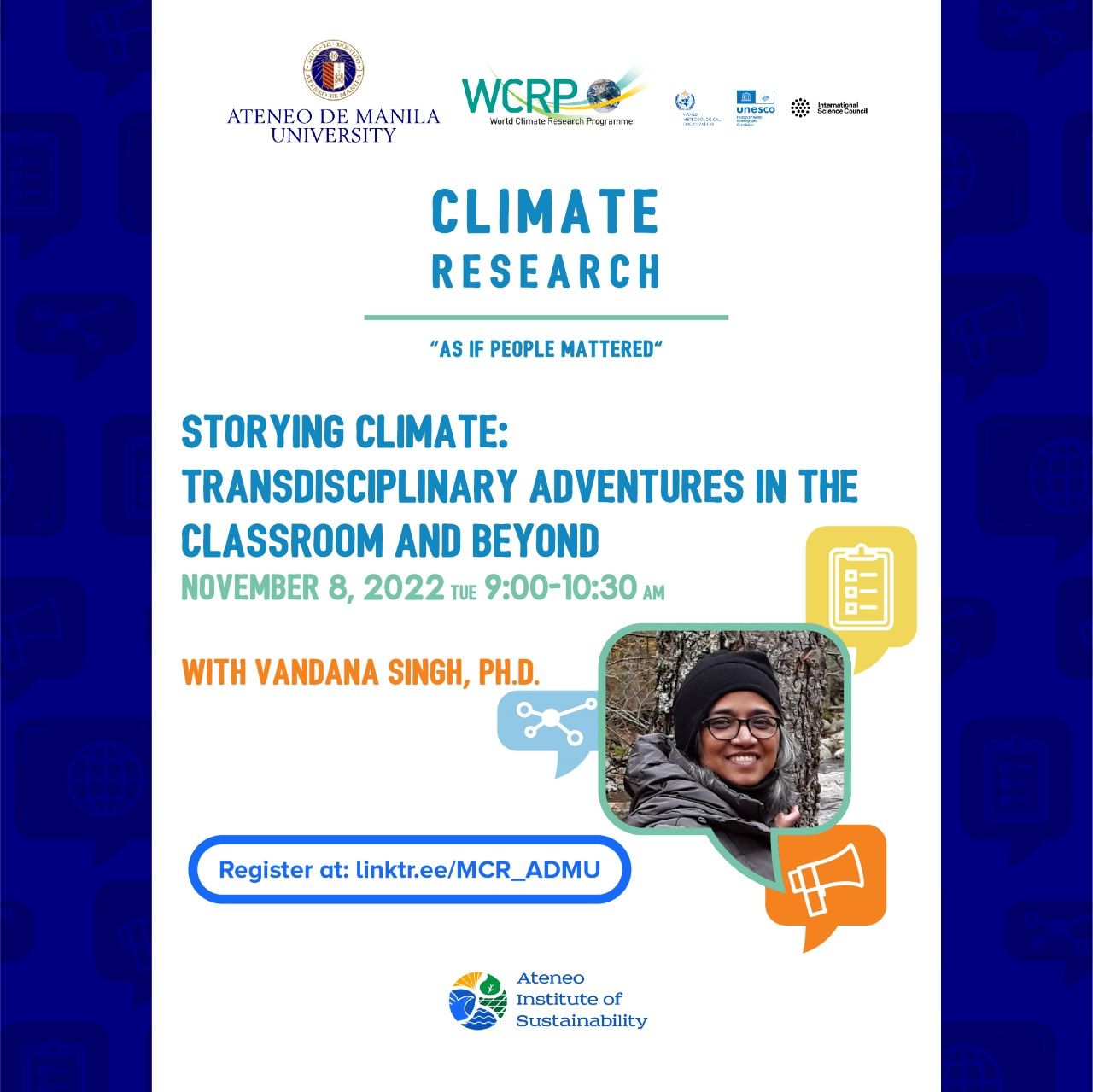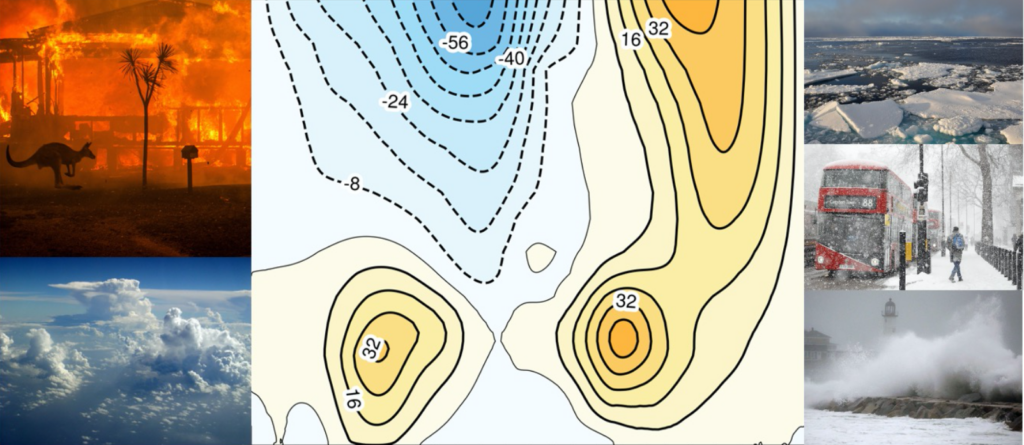Join the first session of this 4-part webinar series to share perspectives and approaches to do climate science, communication, and risk management, taking place on 8 November, 01:00-02:30 UTC.
Please register for the session here.

Join the first session of this 4-part webinar series to share perspectives and approaches to do climate science, communication, and risk management, taking place on 8 November, 01:00-02:30 UTC.
Please register for the session here.

The Committee on Space Research (COSPAR) will be holding two conferences int he coming two years:
5th Symposium of the Committee on Space Research (COSPAR): Space Science with Small Satellites “COSPAR 2023”
Date: 16 – 21 April 2023
Place: Singapore
Contact: COSPAR Secretariat
https://www.cospar-assembly.org (scientific program, abstract submission)
https://www.cospar2023.org/ (registration, accommodation, etc.)
Host Organizations:
Nanyang Technical University and the Office for Space Technology and Industry, Singapore
Abstract Deadline: 31 December 2022
Topics:
Selected papers published in Advances in Space Research and Life Sciences in Space Research, fully refereed journals with no deadlines open to all submissions in relevant fields.
45th Scientific Assembly of the Committee on Space Research (COSPAR) and Associated Events “COSPAR 2024”
Date: 13 – 21 July 2024
Place: Busan, South Korea
Contact: COSPAR Secretariat
https://www.cospar-assembly.org (scientific program, abstract submission)
https://www.cospar2024.org/ (registration, accommodation, etc.)
Host Organizations:
Ministry of Science and ICT, Korean National Committee for COSPAR
Organizers:
Korea Astronomy and Space Science Institute (KASI), The Korean Space Science Society
Abstract Deadline: mid-February 2024
Topics:
Approximately 140 meetings covering the fields of COSPAR Scientific Commissions (SC), Panels, and Task Groups:
Selected papers published in Advances in Space Research and Life Sciences in Space Research, fully refereed journals with no deadlines open to all submissions in relevant fields.
23 November, 10:30 – 12:00 CET
Join us for a webinar on cloud feedbacks and atmospheric dynamics from the latest series on tipping elements, irreversibility, and abrupt changes in the Earth system from the WCRP Lighthouse Activity on Safe Landing Climates, AIMES, the Earth Commission, and Future Earth. It will take place on 23 November, 10:30 – 12:00 CET.
Our two speakers are Caroline Muller (Institute of Science and Technology Austria) who will talk about the spontaneous aggregation of convective storms and Rodrigo Caballero (Stockholm University) who will discuss the transition to superrotation in warm climates. The webinar will be moderated by Steven Sherwood (The University of New South Wales).
To register, please see the event website.

A selection of new science articles from the past week of interest to the SPARC community (a SPARC Office choice).
Near Global Distributions of Overshooting Tops Derived from Terra and Aqua MODIS Observations. By Y. Hong et al. in Atmospheric Measurement Techniques.
Modelling SO2 conversion into sulfates in the mid-troposphere with a 3D chemistry transport model: the case of Mount Etna’s eruption on 12 April 2012. By M. Lachatre et al. in Atmospheric Chemistry and Physics.
Calibration and Uncertainty Quantification of a Gravity Wave Parameterization: A Case Study of the Quasi-Biennial Oscillation in an Intermediate Complexity Climate Model. By L.A. Mansfield and A. Sheshadri in the Journal of Advances in Modeling Earth Systems.
Tracking water in the Tongan volcano’s massive eruption plume. By S. Stanley in EOS.
Faster Tropical Upper Stratospheric Upwelling Drives Changes in Ozone Chemistry. By S.E. Strahan et al. in the Geophysical Research Letters.
Global tropospheric ozone trends, attributions, and radiative impacts in 1995–2017: an integrated analysis using aircraft (IAGOS) observations, ozonesonde, and multi-decadal chemical model simulations. By H. Wang et al. in Atmospheric Chemistry and Physics.
Discussion papers – open for comment:
SO2 enhances aerosol formation from anthropogenic volatile organic compound ozonolysis by producing sulfur-containing compounds. By Z. Yang et al. in the EGUsphere.

The WCRP Explaining and Predicting Earth System Change Lighthouse Activity invites you to join the second webinar of the series that will provide a discussion forum on topics focused on predicting and explaining a range of different climate phenomena and events, while supporting the further development of a scientific agenda.
This second webinar will focus on the Triple La Niña and will provide a view of causes, key processes and prediction of such event.
SPEAKERS:
The event will take place on 22November 2022, from 15:00hs to 16:30hs UTC. Speakers will give a 20-minute talk each followed by a round table discussion, with questions from participants.
Registrations are free, https://EPESC-webinar-triple-la-nina.eventbrite.co.uk
The DynVar and SNAP activities are going to hold a joint meeting in Munich in October 2023:
The Role of Atmospheric Dynamics for Climate and Extremes
9-13 October 2023 at the Meteorological Institute at Ludwig-Maximilians- University Munich, Germany

Scientific Program
• Links of atmospheric circulation to weather and climate on subseasonal to centennial timescales
• The role of stratosphere-troposphere coupling in predictability of tropospheric climate and surface weather extremes
• The influence of climate model biases on uncertainty in predictions and projections
• Emerging dynamical constraints to understand and reduce projection uncertainties
• Mechanistic understanding of dynamic coupling, teleconnections, and trends
We anticipate travel support for early career scientists and
attendees from developing nations.
Deadlines will be announced in early 2023
Find out latest updates and more on the meeting webpage
Modeling Stratosphere-Troposphere Coupling in a Changing Climate. By W.J. Randel and G. Chen in EOS.
Setting the Stage for Climate Action Under the Montreal Protocol. By S.O. Andersen, M. Gonzalez, and N.J. Sherman in EOS.
Chemical analysis of the Asian tropopause aerosol layer (ATAL) with emphasis on secondary aerosol particles using aircraft-based in situ aerosol mass spectrometry. By O. Appel et al. in Atmospheric Chemistry and Physics.
On the Ridging of the South Atlantic Anticyclone Over South Africa: The Impact of Rossby Wave Breaking and of Climate Change. By I. Ivanciu et al. in the Geophysical Research Letters.
Discussion papers – open for comment:
South Pole Station ozonesondes: variability and trends in the springtime Antarctic ozone hole 1986–2021. By B.J. Johnson et al. in Atmospheric Chemistry and Physics – Discussions.
Dynamics of ENSO-driven stratosphere-to-troposphere transport of ozone over North America. By J.R. Albers et al. in Atmospheric Chemistry and Physics.
Tropospheric Expansion Under Global Warming Reduces Tropical Lower Stratospheric Ozone. By Aaron Match and Edwin P. Gerber in the Geophysical Research Letters.
Phase unlocking and the modulation of tropopause-level trace gas advection by the quasibiennial oscillation. By K. Shah et al. in the Journal of Geophysical Research: Atmospheres.
Discussion papers – open for comment:
Signatures of the Madden-Julian Oscillation in Middle Atmosphere zonal mean Temperature: Triggering the Interhemispheric Coupling pattern. By C.G. Hoffmann, L.G. Buth, and C. von Savigny in the EGUSphere.
Indicators of the ozone recovery for selected sites in the Northern Hemisphere mid-latitudes derived from various total column ozone datasets (1980–2020). By J. Krzyścin in Atmospheric Chemistry and Physics.
If you are interested, please send a maximum of two pages covering the following questions (DUE November 10, 2022):
1. What are you hoping to get out of participating in an iCACGP-IGAC steering committee?
2. What will you bring to the steering committee?
3. What ideas do you have for this steering committee?
To
Please also submit a CV with your application
Note that, as this is the first committee, we are allowing you to self-identify as early career (no strict definition of years after graduation). We would like you to shape this committee, so we are open to your ideas in your application letter.
A selection of new science articles from the past week of interest to the SPARC community (a SPARC Office choice).
Analysis of turbulence reports and ERA5 turbulence diagnostics in a tropopause-based vertical framework. By T. Kaluza, D. Kunkel, and P. Hoor in the Geophysical Research Letters.
Diverse surface signatures of stratospheric polar vortex anomalies. By E.W. Kolstad et al. in the Journal of Geophysical Research: Atmospheres.
Signatures of Anomalous Transport in the 2019/2020 Arctic Stratospheric Polar Vortex. By G.L. Manney et al. in the Journal of Geophysical Research: Atmospheres.
Discussion papers – open for comment:
Distribution of cross-tropopause convection within the Asian monsoon region from May through October 2017. By C.E. Clapp et al. in Atmospheric Chemistry and Physics.